Analysis of Capital Allocation in International Trade Finance Report
VerifiedAdded on 2022/12/30
|12
|3743
|68
Report
AI Summary
This report provides a comprehensive analysis of capital allocation within the context of international trade finance. It begins with an introduction to the concept of capital allocation, emphasizing its importance for maximizing profitability and organizational success. The report then delves into the background of financial markets, outlining different types such as over-the-counter, bond, money, derivative, and forex markets. The core of the report examines capital allocation within both domestic and international economies, focusing on the UK, China, and US. It explores the factors influencing capital allocation, including macroeconomic and microeconomic environments, foreign direct investment, and the transformation of financial markets. The report also evaluates the UK economy, analyzes challenges related to industrialization and trade policies, and concludes with a summary of key findings and recommendations. The report provides valuable insights into the complexities of international finance and its impact on global economies. This assignment is available on Desklib, the platform for AI-driven study tools.
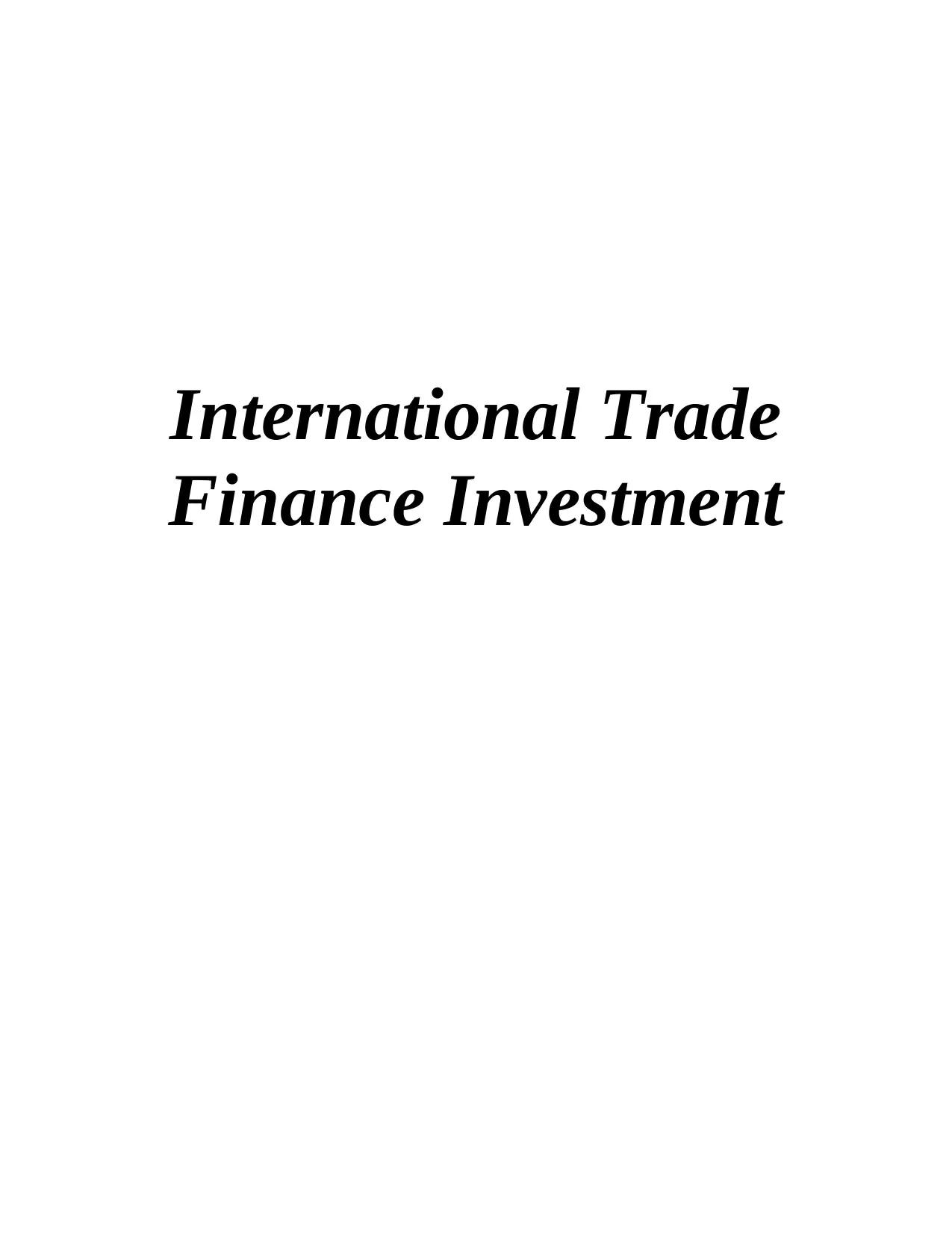
International Trade
Finance Investment
Finance Investment
Paraphrase This Document
Need a fresh take? Get an instant paraphrase of this document with our AI Paraphraser
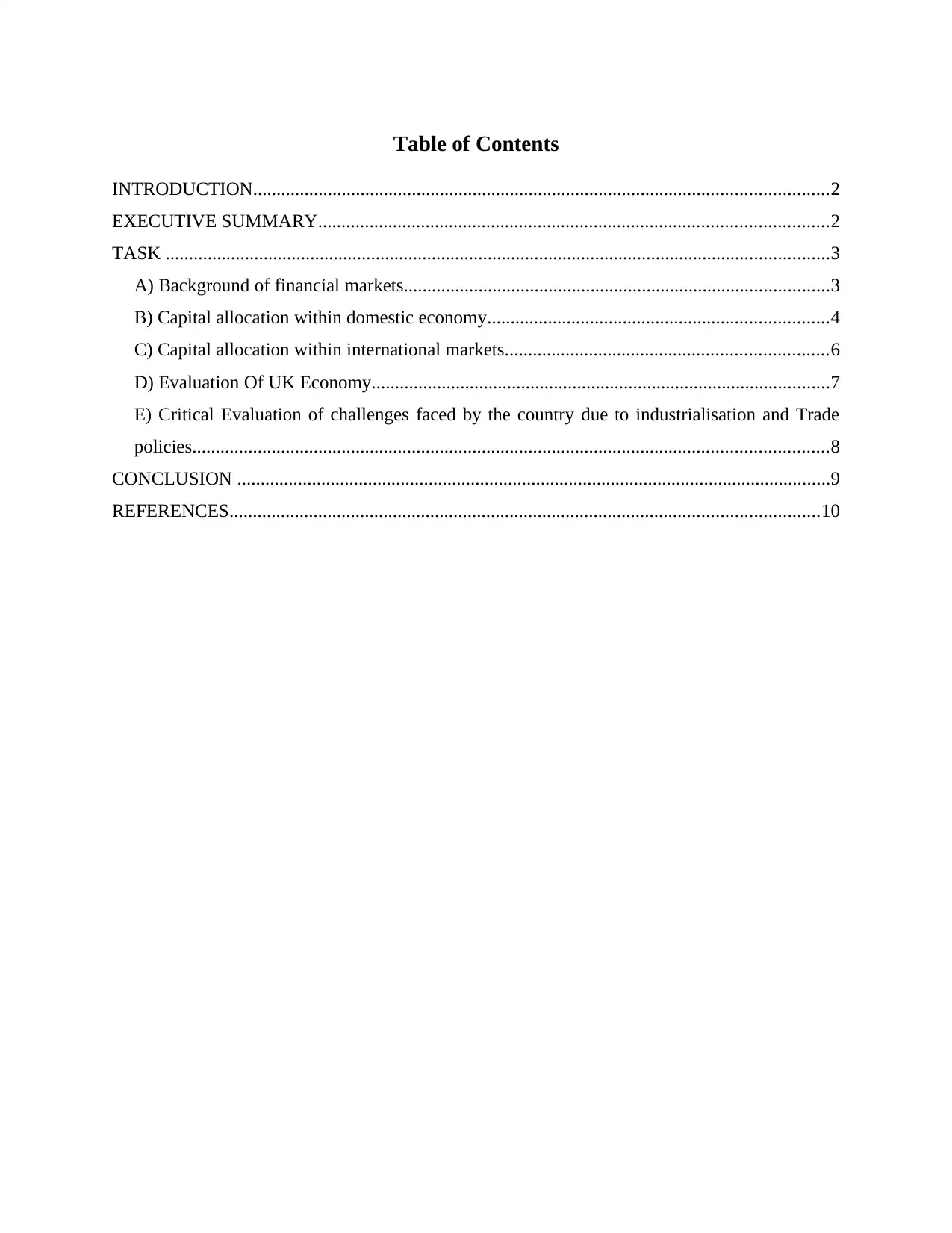
Table of Contents
INTRODUCTION...........................................................................................................................2
EXECUTIVE SUMMARY.............................................................................................................2
TASK ..............................................................................................................................................3
A) Background of financial markets...........................................................................................3
B) Capital allocation within domestic economy.........................................................................4
C) Capital allocation within international markets.....................................................................6
D) Evaluation Of UK Economy..................................................................................................7
E) Critical Evaluation of challenges faced by the country due to industrialisation and Trade
policies........................................................................................................................................8
CONCLUSION ...............................................................................................................................9
REFERENCES..............................................................................................................................10
INTRODUCTION...........................................................................................................................2
EXECUTIVE SUMMARY.............................................................................................................2
TASK ..............................................................................................................................................3
A) Background of financial markets...........................................................................................3
B) Capital allocation within domestic economy.........................................................................4
C) Capital allocation within international markets.....................................................................6
D) Evaluation Of UK Economy..................................................................................................7
E) Critical Evaluation of challenges faced by the country due to industrialisation and Trade
policies........................................................................................................................................8
CONCLUSION ...............................................................................................................................9
REFERENCES..............................................................................................................................10
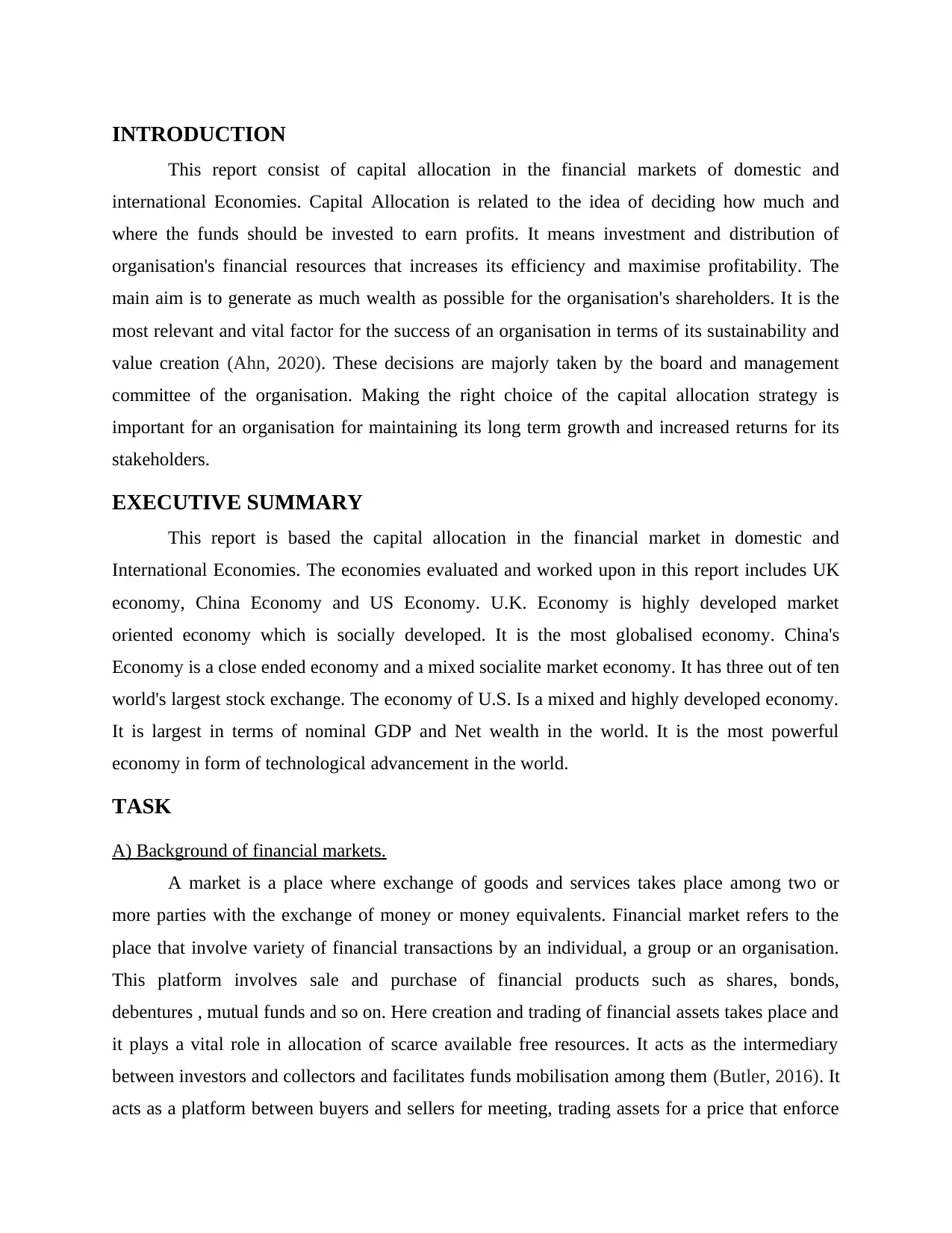
INTRODUCTION
This report consist of capital allocation in the financial markets of domestic and
international Economies. Capital Allocation is related to the idea of deciding how much and
where the funds should be invested to earn profits. It means investment and distribution of
organisation's financial resources that increases its efficiency and maximise profitability. The
main aim is to generate as much wealth as possible for the organisation's shareholders. It is the
most relevant and vital factor for the success of an organisation in terms of its sustainability and
value creation (Ahn, 2020). These decisions are majorly taken by the board and management
committee of the organisation. Making the right choice of the capital allocation strategy is
important for an organisation for maintaining its long term growth and increased returns for its
stakeholders.
EXECUTIVE SUMMARY
This report is based the capital allocation in the financial market in domestic and
International Economies. The economies evaluated and worked upon in this report includes UK
economy, China Economy and US Economy. U.K. Economy is highly developed market
oriented economy which is socially developed. It is the most globalised economy. China's
Economy is a close ended economy and a mixed socialite market economy. It has three out of ten
world's largest stock exchange. The economy of U.S. Is a mixed and highly developed economy.
It is largest in terms of nominal GDP and Net wealth in the world. It is the most powerful
economy in form of technological advancement in the world.
TASK
A) Background of financial markets.
A market is a place where exchange of goods and services takes place among two or
more parties with the exchange of money or money equivalents. Financial market refers to the
place that involve variety of financial transactions by an individual, a group or an organisation.
This platform involves sale and purchase of financial products such as shares, bonds,
debentures , mutual funds and so on. Here creation and trading of financial assets takes place and
it plays a vital role in allocation of scarce available free resources. It acts as the intermediary
between investors and collectors and facilitates funds mobilisation among them (Butler, 2016). It
acts as a platform between buyers and sellers for meeting, trading assets for a price that enforce
This report consist of capital allocation in the financial markets of domestic and
international Economies. Capital Allocation is related to the idea of deciding how much and
where the funds should be invested to earn profits. It means investment and distribution of
organisation's financial resources that increases its efficiency and maximise profitability. The
main aim is to generate as much wealth as possible for the organisation's shareholders. It is the
most relevant and vital factor for the success of an organisation in terms of its sustainability and
value creation (Ahn, 2020). These decisions are majorly taken by the board and management
committee of the organisation. Making the right choice of the capital allocation strategy is
important for an organisation for maintaining its long term growth and increased returns for its
stakeholders.
EXECUTIVE SUMMARY
This report is based the capital allocation in the financial market in domestic and
International Economies. The economies evaluated and worked upon in this report includes UK
economy, China Economy and US Economy. U.K. Economy is highly developed market
oriented economy which is socially developed. It is the most globalised economy. China's
Economy is a close ended economy and a mixed socialite market economy. It has three out of ten
world's largest stock exchange. The economy of U.S. Is a mixed and highly developed economy.
It is largest in terms of nominal GDP and Net wealth in the world. It is the most powerful
economy in form of technological advancement in the world.
TASK
A) Background of financial markets.
A market is a place where exchange of goods and services takes place among two or
more parties with the exchange of money or money equivalents. Financial market refers to the
place that involve variety of financial transactions by an individual, a group or an organisation.
This platform involves sale and purchase of financial products such as shares, bonds,
debentures , mutual funds and so on. Here creation and trading of financial assets takes place and
it plays a vital role in allocation of scarce available free resources. It acts as the intermediary
between investors and collectors and facilitates funds mobilisation among them (Butler, 2016). It
acts as a platform between buyers and sellers for meeting, trading assets for a price that enforce
⊘ This is a preview!⊘
Do you want full access?
Subscribe today to unlock all pages.

Trusted by 1+ million students worldwide
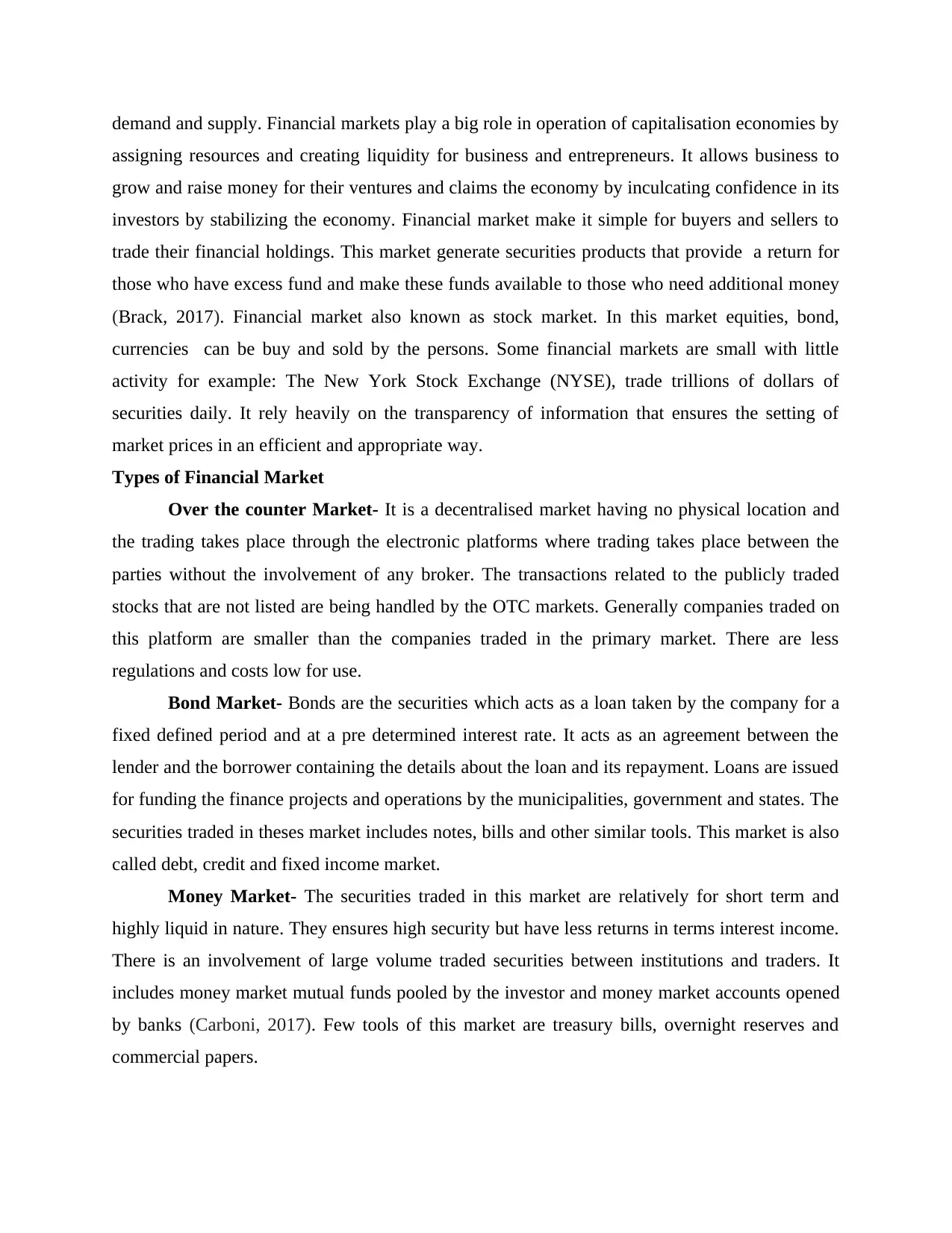
demand and supply. Financial markets play a big role in operation of capitalisation economies by
assigning resources and creating liquidity for business and entrepreneurs. It allows business to
grow and raise money for their ventures and claims the economy by inculcating confidence in its
investors by stabilizing the economy. Financial market make it simple for buyers and sellers to
trade their financial holdings. This market generate securities products that provide a return for
those who have excess fund and make these funds available to those who need additional money
(Brack, 2017). Financial market also known as stock market. In this market equities, bond,
currencies can be buy and sold by the persons. Some financial markets are small with little
activity for example: The New York Stock Exchange (NYSE), trade trillions of dollars of
securities daily. It rely heavily on the transparency of information that ensures the setting of
market prices in an efficient and appropriate way.
Types of Financial Market
Over the counter Market- It is a decentralised market having no physical location and
the trading takes place through the electronic platforms where trading takes place between the
parties without the involvement of any broker. The transactions related to the publicly traded
stocks that are not listed are being handled by the OTC markets. Generally companies traded on
this platform are smaller than the companies traded in the primary market. There are less
regulations and costs low for use.
Bond Market- Bonds are the securities which acts as a loan taken by the company for a
fixed defined period and at a pre determined interest rate. It acts as an agreement between the
lender and the borrower containing the details about the loan and its repayment. Loans are issued
for funding the finance projects and operations by the municipalities, government and states. The
securities traded in theses market includes notes, bills and other similar tools. This market is also
called debt, credit and fixed income market.
Money Market- The securities traded in this market are relatively for short term and
highly liquid in nature. They ensures high security but have less returns in terms interest income.
There is an involvement of large volume traded securities between institutions and traders. It
includes money market mutual funds pooled by the investor and money market accounts opened
by banks (Carboni, 2017). Few tools of this market are treasury bills, overnight reserves and
commercial papers.
assigning resources and creating liquidity for business and entrepreneurs. It allows business to
grow and raise money for their ventures and claims the economy by inculcating confidence in its
investors by stabilizing the economy. Financial market make it simple for buyers and sellers to
trade their financial holdings. This market generate securities products that provide a return for
those who have excess fund and make these funds available to those who need additional money
(Brack, 2017). Financial market also known as stock market. In this market equities, bond,
currencies can be buy and sold by the persons. Some financial markets are small with little
activity for example: The New York Stock Exchange (NYSE), trade trillions of dollars of
securities daily. It rely heavily on the transparency of information that ensures the setting of
market prices in an efficient and appropriate way.
Types of Financial Market
Over the counter Market- It is a decentralised market having no physical location and
the trading takes place through the electronic platforms where trading takes place between the
parties without the involvement of any broker. The transactions related to the publicly traded
stocks that are not listed are being handled by the OTC markets. Generally companies traded on
this platform are smaller than the companies traded in the primary market. There are less
regulations and costs low for use.
Bond Market- Bonds are the securities which acts as a loan taken by the company for a
fixed defined period and at a pre determined interest rate. It acts as an agreement between the
lender and the borrower containing the details about the loan and its repayment. Loans are issued
for funding the finance projects and operations by the municipalities, government and states. The
securities traded in theses market includes notes, bills and other similar tools. This market is also
called debt, credit and fixed income market.
Money Market- The securities traded in this market are relatively for short term and
highly liquid in nature. They ensures high security but have less returns in terms interest income.
There is an involvement of large volume traded securities between institutions and traders. It
includes money market mutual funds pooled by the investor and money market accounts opened
by banks (Carboni, 2017). Few tools of this market are treasury bills, overnight reserves and
commercial papers.
Paraphrase This Document
Need a fresh take? Get an instant paraphrase of this document with our AI Paraphraser
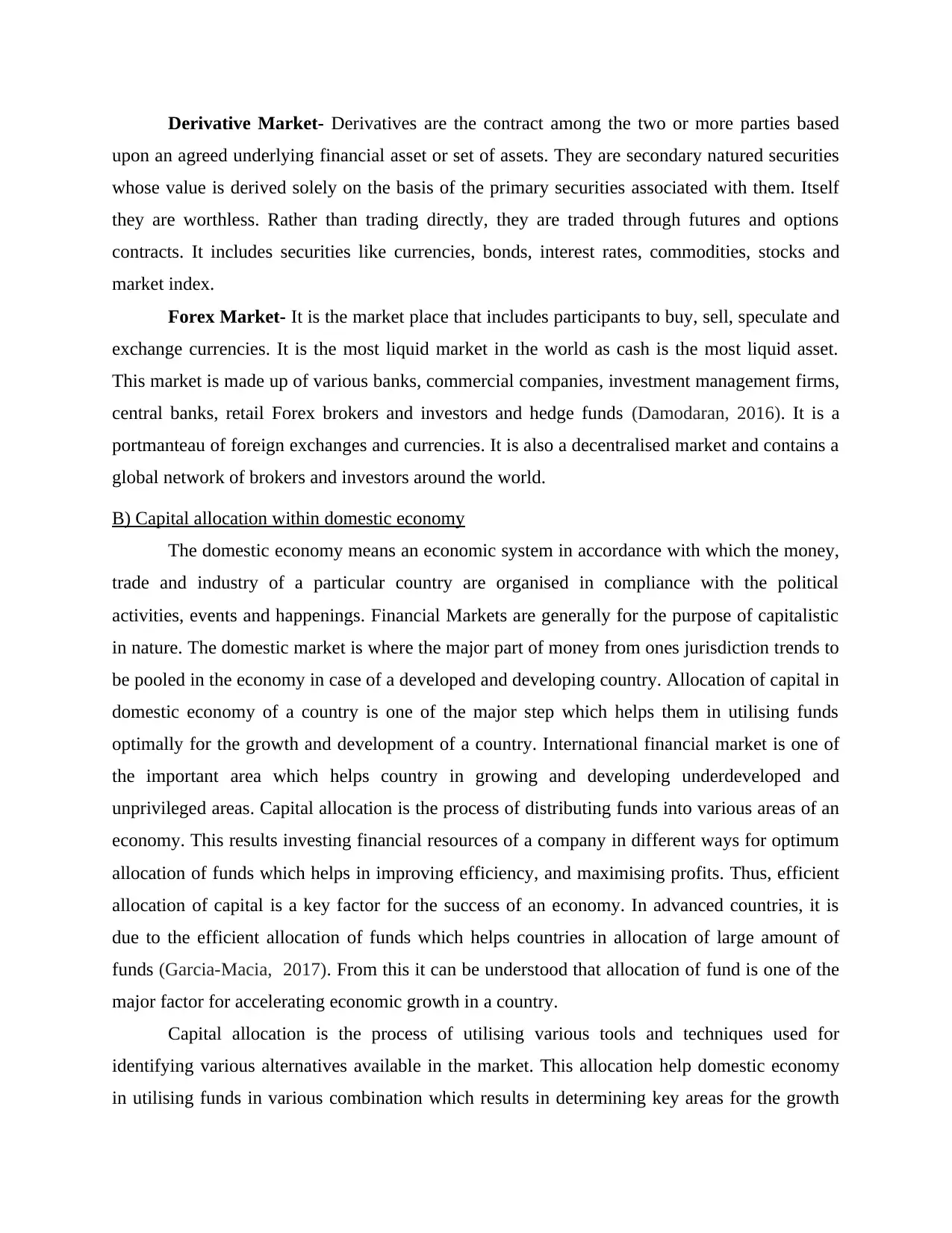
Derivative Market- Derivatives are the contract among the two or more parties based
upon an agreed underlying financial asset or set of assets. They are secondary natured securities
whose value is derived solely on the basis of the primary securities associated with them. Itself
they are worthless. Rather than trading directly, they are traded through futures and options
contracts. It includes securities like currencies, bonds, interest rates, commodities, stocks and
market index.
Forex Market- It is the market place that includes participants to buy, sell, speculate and
exchange currencies. It is the most liquid market in the world as cash is the most liquid asset.
This market is made up of various banks, commercial companies, investment management firms,
central banks, retail Forex brokers and investors and hedge funds (Damodaran, 2016). It is a
portmanteau of foreign exchanges and currencies. It is also a decentralised market and contains a
global network of brokers and investors around the world.
B) Capital allocation within domestic economy
The domestic economy means an economic system in accordance with which the money,
trade and industry of a particular country are organised in compliance with the political
activities, events and happenings. Financial Markets are generally for the purpose of capitalistic
in nature. The domestic market is where the major part of money from ones jurisdiction trends to
be pooled in the economy in case of a developed and developing country. Allocation of capital in
domestic economy of a country is one of the major step which helps them in utilising funds
optimally for the growth and development of a country. International financial market is one of
the important area which helps country in growing and developing underdeveloped and
unprivileged areas. Capital allocation is the process of distributing funds into various areas of an
economy. This results investing financial resources of a company in different ways for optimum
allocation of funds which helps in improving efficiency, and maximising profits. Thus, efficient
allocation of capital is a key factor for the success of an economy. In advanced countries, it is
due to the efficient allocation of funds which helps countries in allocation of large amount of
funds (Garcia-Macia, 2017). From this it can be understood that allocation of fund is one of the
major factor for accelerating economic growth in a country.
Capital allocation is the process of utilising various tools and techniques used for
identifying various alternatives available in the market. This allocation help domestic economy
in utilising funds in various combination which results in determining key areas for the growth
upon an agreed underlying financial asset or set of assets. They are secondary natured securities
whose value is derived solely on the basis of the primary securities associated with them. Itself
they are worthless. Rather than trading directly, they are traded through futures and options
contracts. It includes securities like currencies, bonds, interest rates, commodities, stocks and
market index.
Forex Market- It is the market place that includes participants to buy, sell, speculate and
exchange currencies. It is the most liquid market in the world as cash is the most liquid asset.
This market is made up of various banks, commercial companies, investment management firms,
central banks, retail Forex brokers and investors and hedge funds (Damodaran, 2016). It is a
portmanteau of foreign exchanges and currencies. It is also a decentralised market and contains a
global network of brokers and investors around the world.
B) Capital allocation within domestic economy
The domestic economy means an economic system in accordance with which the money,
trade and industry of a particular country are organised in compliance with the political
activities, events and happenings. Financial Markets are generally for the purpose of capitalistic
in nature. The domestic market is where the major part of money from ones jurisdiction trends to
be pooled in the economy in case of a developed and developing country. Allocation of capital in
domestic economy of a country is one of the major step which helps them in utilising funds
optimally for the growth and development of a country. International financial market is one of
the important area which helps country in growing and developing underdeveloped and
unprivileged areas. Capital allocation is the process of distributing funds into various areas of an
economy. This results investing financial resources of a company in different ways for optimum
allocation of funds which helps in improving efficiency, and maximising profits. Thus, efficient
allocation of capital is a key factor for the success of an economy. In advanced countries, it is
due to the efficient allocation of funds which helps countries in allocation of large amount of
funds (Garcia-Macia, 2017). From this it can be understood that allocation of fund is one of the
major factor for accelerating economic growth in a country.
Capital allocation is the process of utilising various tools and techniques used for
identifying various alternatives available in the market. This allocation help domestic economy
in utilising funds in various combination which results in determining key areas for the growth
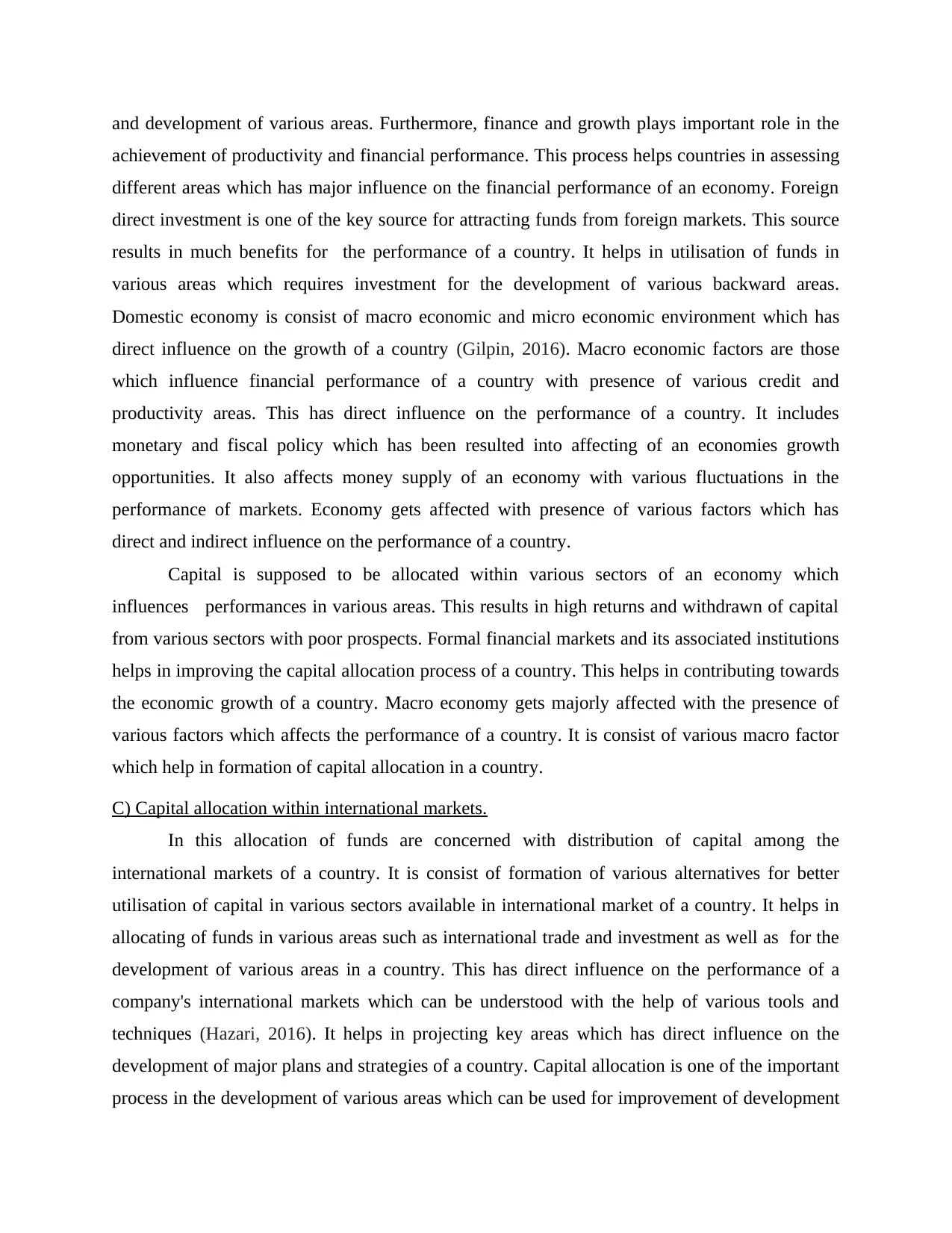
and development of various areas. Furthermore, finance and growth plays important role in the
achievement of productivity and financial performance. This process helps countries in assessing
different areas which has major influence on the financial performance of an economy. Foreign
direct investment is one of the key source for attracting funds from foreign markets. This source
results in much benefits for the performance of a country. It helps in utilisation of funds in
various areas which requires investment for the development of various backward areas.
Domestic economy is consist of macro economic and micro economic environment which has
direct influence on the growth of a country (Gilpin, 2016). Macro economic factors are those
which influence financial performance of a country with presence of various credit and
productivity areas. This has direct influence on the performance of a country. It includes
monetary and fiscal policy which has been resulted into affecting of an economies growth
opportunities. It also affects money supply of an economy with various fluctuations in the
performance of markets. Economy gets affected with presence of various factors which has
direct and indirect influence on the performance of a country.
Capital is supposed to be allocated within various sectors of an economy which
influences performances in various areas. This results in high returns and withdrawn of capital
from various sectors with poor prospects. Formal financial markets and its associated institutions
helps in improving the capital allocation process of a country. This helps in contributing towards
the economic growth of a country. Macro economy gets majorly affected with the presence of
various factors which affects the performance of a country. It is consist of various macro factor
which help in formation of capital allocation in a country.
C) Capital allocation within international markets.
In this allocation of funds are concerned with distribution of capital among the
international markets of a country. It is consist of formation of various alternatives for better
utilisation of capital in various sectors available in international market of a country. It helps in
allocating of funds in various areas such as international trade and investment as well as for the
development of various areas in a country. This has direct influence on the performance of a
company's international markets which can be understood with the help of various tools and
techniques (Hazari, 2016). It helps in projecting key areas which has direct influence on the
development of major plans and strategies of a country. Capital allocation is one of the important
process in the development of various areas which can be used for improvement of development
achievement of productivity and financial performance. This process helps countries in assessing
different areas which has major influence on the financial performance of an economy. Foreign
direct investment is one of the key source for attracting funds from foreign markets. This source
results in much benefits for the performance of a country. It helps in utilisation of funds in
various areas which requires investment for the development of various backward areas.
Domestic economy is consist of macro economic and micro economic environment which has
direct influence on the growth of a country (Gilpin, 2016). Macro economic factors are those
which influence financial performance of a country with presence of various credit and
productivity areas. This has direct influence on the performance of a country. It includes
monetary and fiscal policy which has been resulted into affecting of an economies growth
opportunities. It also affects money supply of an economy with various fluctuations in the
performance of markets. Economy gets affected with presence of various factors which has
direct and indirect influence on the performance of a country.
Capital is supposed to be allocated within various sectors of an economy which
influences performances in various areas. This results in high returns and withdrawn of capital
from various sectors with poor prospects. Formal financial markets and its associated institutions
helps in improving the capital allocation process of a country. This helps in contributing towards
the economic growth of a country. Macro economy gets majorly affected with the presence of
various factors which affects the performance of a country. It is consist of various macro factor
which help in formation of capital allocation in a country.
C) Capital allocation within international markets.
In this allocation of funds are concerned with distribution of capital among the
international markets of a country. It is consist of formation of various alternatives for better
utilisation of capital in various sectors available in international market of a country. It helps in
allocating of funds in various areas such as international trade and investment as well as for the
development of various areas in a country. This has direct influence on the performance of a
company's international markets which can be understood with the help of various tools and
techniques (Hazari, 2016). It helps in projecting key areas which has direct influence on the
development of major plans and strategies of a country. Capital allocation is one of the important
process in the development of various areas which can be used for improvement of development
⊘ This is a preview!⊘
Do you want full access?
Subscribe today to unlock all pages.

Trusted by 1+ million students worldwide
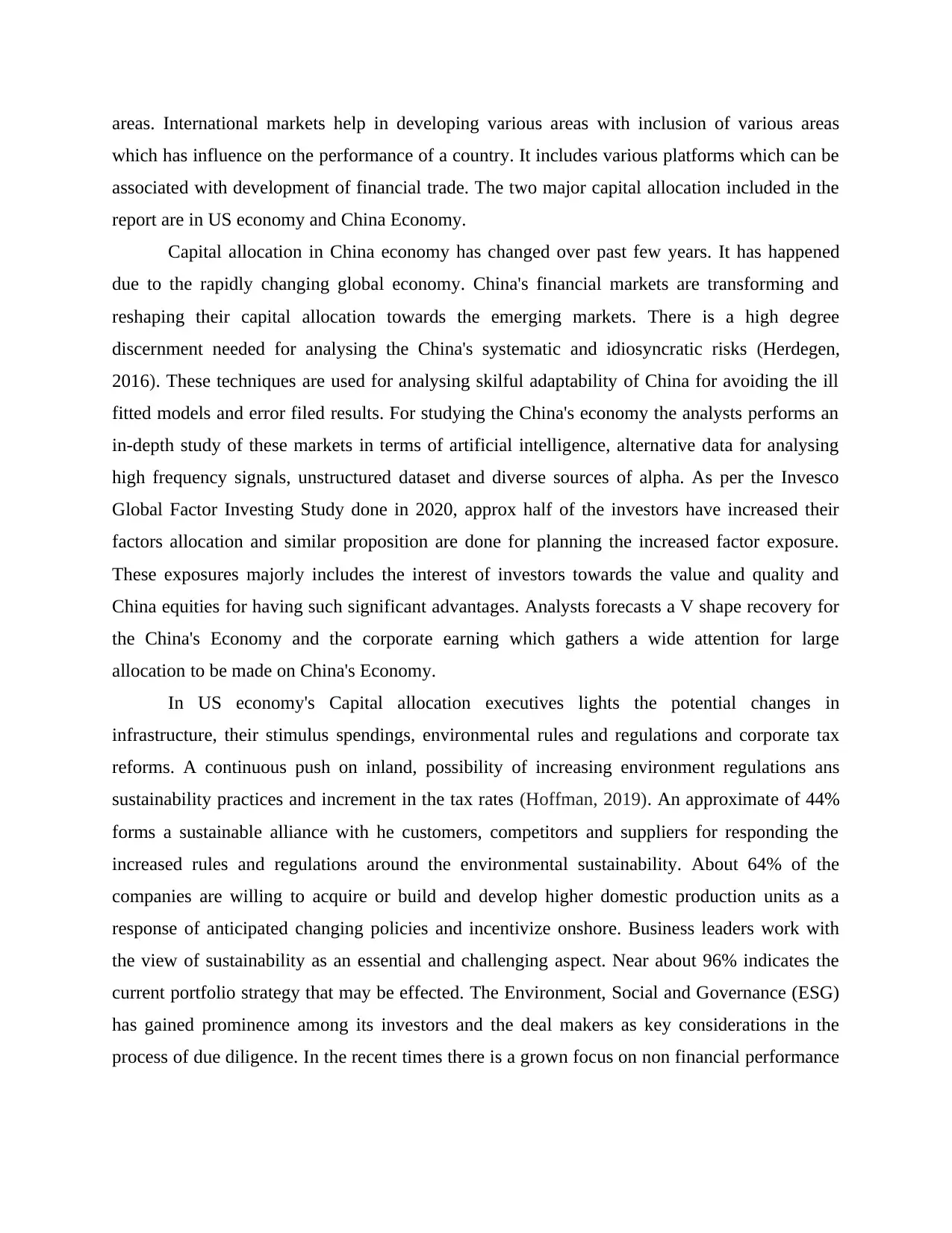
areas. International markets help in developing various areas with inclusion of various areas
which has influence on the performance of a country. It includes various platforms which can be
associated with development of financial trade. The two major capital allocation included in the
report are in US economy and China Economy.
Capital allocation in China economy has changed over past few years. It has happened
due to the rapidly changing global economy. China's financial markets are transforming and
reshaping their capital allocation towards the emerging markets. There is a high degree
discernment needed for analysing the China's systematic and idiosyncratic risks (Herdegen,
2016). These techniques are used for analysing skilful adaptability of China for avoiding the ill
fitted models and error filed results. For studying the China's economy the analysts performs an
in-depth study of these markets in terms of artificial intelligence, alternative data for analysing
high frequency signals, unstructured dataset and diverse sources of alpha. As per the Invesco
Global Factor Investing Study done in 2020, approx half of the investors have increased their
factors allocation and similar proposition are done for planning the increased factor exposure.
These exposures majorly includes the interest of investors towards the value and quality and
China equities for having such significant advantages. Analysts forecasts a V shape recovery for
the China's Economy and the corporate earning which gathers a wide attention for large
allocation to be made on China's Economy.
In US economy's Capital allocation executives lights the potential changes in
infrastructure, their stimulus spendings, environmental rules and regulations and corporate tax
reforms. A continuous push on inland, possibility of increasing environment regulations ans
sustainability practices and increment in the tax rates (Hoffman, 2019). An approximate of 44%
forms a sustainable alliance with he customers, competitors and suppliers for responding the
increased rules and regulations around the environmental sustainability. About 64% of the
companies are willing to acquire or build and develop higher domestic production units as a
response of anticipated changing policies and incentivize onshore. Business leaders work with
the view of sustainability as an essential and challenging aspect. Near about 96% indicates the
current portfolio strategy that may be effected. The Environment, Social and Governance (ESG)
has gained prominence among its investors and the deal makers as key considerations in the
process of due diligence. In the recent times there is a grown focus on non financial performance
which has influence on the performance of a country. It includes various platforms which can be
associated with development of financial trade. The two major capital allocation included in the
report are in US economy and China Economy.
Capital allocation in China economy has changed over past few years. It has happened
due to the rapidly changing global economy. China's financial markets are transforming and
reshaping their capital allocation towards the emerging markets. There is a high degree
discernment needed for analysing the China's systematic and idiosyncratic risks (Herdegen,
2016). These techniques are used for analysing skilful adaptability of China for avoiding the ill
fitted models and error filed results. For studying the China's economy the analysts performs an
in-depth study of these markets in terms of artificial intelligence, alternative data for analysing
high frequency signals, unstructured dataset and diverse sources of alpha. As per the Invesco
Global Factor Investing Study done in 2020, approx half of the investors have increased their
factors allocation and similar proposition are done for planning the increased factor exposure.
These exposures majorly includes the interest of investors towards the value and quality and
China equities for having such significant advantages. Analysts forecasts a V shape recovery for
the China's Economy and the corporate earning which gathers a wide attention for large
allocation to be made on China's Economy.
In US economy's Capital allocation executives lights the potential changes in
infrastructure, their stimulus spendings, environmental rules and regulations and corporate tax
reforms. A continuous push on inland, possibility of increasing environment regulations ans
sustainability practices and increment in the tax rates (Hoffman, 2019). An approximate of 44%
forms a sustainable alliance with he customers, competitors and suppliers for responding the
increased rules and regulations around the environmental sustainability. About 64% of the
companies are willing to acquire or build and develop higher domestic production units as a
response of anticipated changing policies and incentivize onshore. Business leaders work with
the view of sustainability as an essential and challenging aspect. Near about 96% indicates the
current portfolio strategy that may be effected. The Environment, Social and Governance (ESG)
has gained prominence among its investors and the deal makers as key considerations in the
process of due diligence. In the recent times there is a grown focus on non financial performance
Paraphrase This Document
Need a fresh take? Get an instant paraphrase of this document with our AI Paraphraser
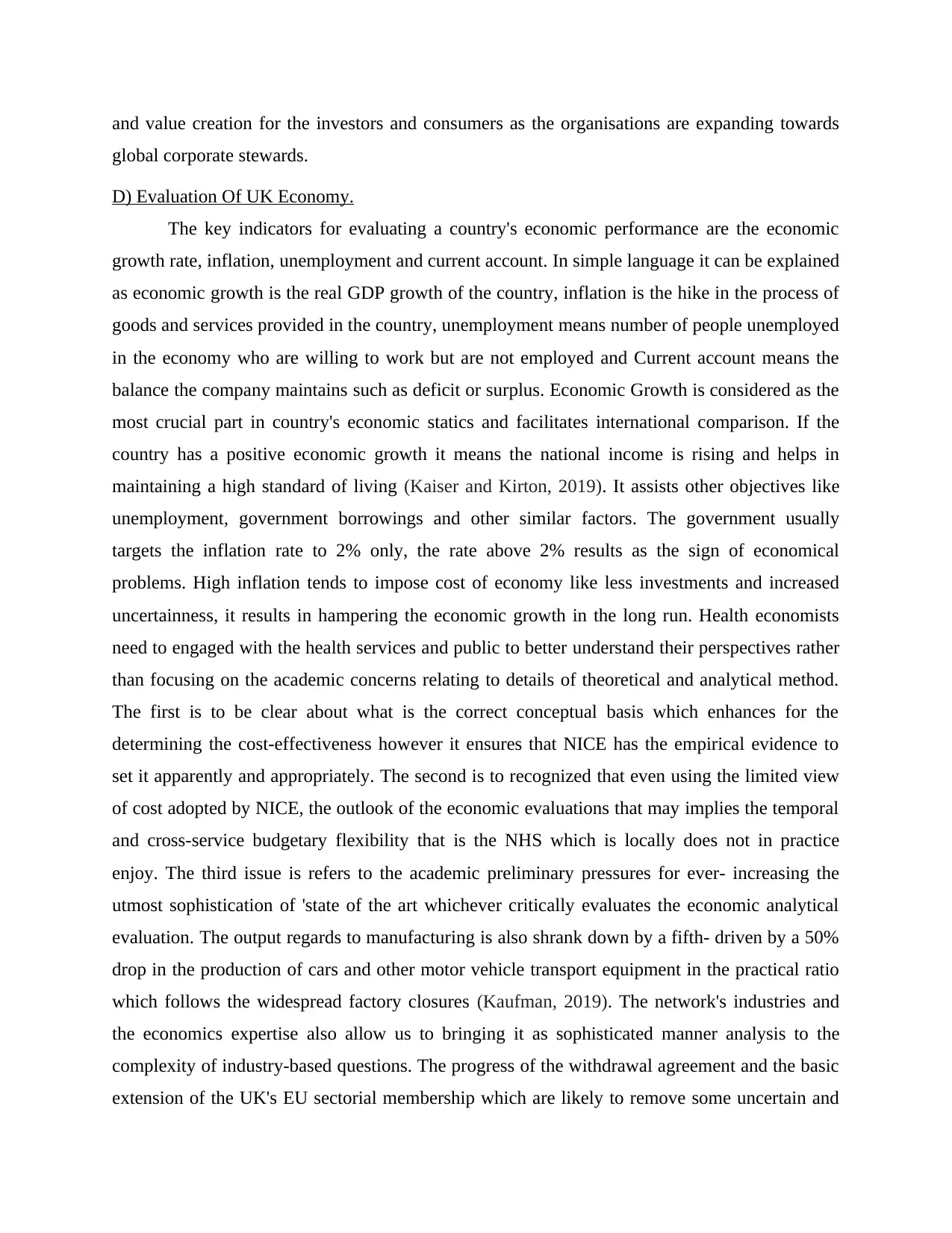
and value creation for the investors and consumers as the organisations are expanding towards
global corporate stewards.
D) Evaluation Of UK Economy.
The key indicators for evaluating a country's economic performance are the economic
growth rate, inflation, unemployment and current account. In simple language it can be explained
as economic growth is the real GDP growth of the country, inflation is the hike in the process of
goods and services provided in the country, unemployment means number of people unemployed
in the economy who are willing to work but are not employed and Current account means the
balance the company maintains such as deficit or surplus. Economic Growth is considered as the
most crucial part in country's economic statics and facilitates international comparison. If the
country has a positive economic growth it means the national income is rising and helps in
maintaining a high standard of living (Kaiser and Kirton, 2019). It assists other objectives like
unemployment, government borrowings and other similar factors. The government usually
targets the inflation rate to 2% only, the rate above 2% results as the sign of economical
problems. High inflation tends to impose cost of economy like less investments and increased
uncertainness, it results in hampering the economic growth in the long run. Health economists
need to engaged with the health services and public to better understand their perspectives rather
than focusing on the academic concerns relating to details of theoretical and analytical method.
The first is to be clear about what is the correct conceptual basis which enhances for the
determining the cost-effectiveness however it ensures that NICE has the empirical evidence to
set it apparently and appropriately. The second is to recognized that even using the limited view
of cost adopted by NICE, the outlook of the economic evaluations that may implies the temporal
and cross-service budgetary flexibility that is the NHS which is locally does not in practice
enjoy. The third issue is refers to the academic preliminary pressures for ever- increasing the
utmost sophistication of 'state of the art whichever critically evaluates the economic analytical
evaluation. The output regards to manufacturing is also shrank down by a fifth- driven by a 50%
drop in the production of cars and other motor vehicle transport equipment in the practical ratio
which follows the widespread factory closures (Kaufman, 2019). The network's industries and
the economics expertise also allow us to bringing it as sophisticated manner analysis to the
complexity of industry-based questions. The progress of the withdrawal agreement and the basic
extension of the UK's EU sectorial membership which are likely to remove some uncertain and
global corporate stewards.
D) Evaluation Of UK Economy.
The key indicators for evaluating a country's economic performance are the economic
growth rate, inflation, unemployment and current account. In simple language it can be explained
as economic growth is the real GDP growth of the country, inflation is the hike in the process of
goods and services provided in the country, unemployment means number of people unemployed
in the economy who are willing to work but are not employed and Current account means the
balance the company maintains such as deficit or surplus. Economic Growth is considered as the
most crucial part in country's economic statics and facilitates international comparison. If the
country has a positive economic growth it means the national income is rising and helps in
maintaining a high standard of living (Kaiser and Kirton, 2019). It assists other objectives like
unemployment, government borrowings and other similar factors. The government usually
targets the inflation rate to 2% only, the rate above 2% results as the sign of economical
problems. High inflation tends to impose cost of economy like less investments and increased
uncertainness, it results in hampering the economic growth in the long run. Health economists
need to engaged with the health services and public to better understand their perspectives rather
than focusing on the academic concerns relating to details of theoretical and analytical method.
The first is to be clear about what is the correct conceptual basis which enhances for the
determining the cost-effectiveness however it ensures that NICE has the empirical evidence to
set it apparently and appropriately. The second is to recognized that even using the limited view
of cost adopted by NICE, the outlook of the economic evaluations that may implies the temporal
and cross-service budgetary flexibility that is the NHS which is locally does not in practice
enjoy. The third issue is refers to the academic preliminary pressures for ever- increasing the
utmost sophistication of 'state of the art whichever critically evaluates the economic analytical
evaluation. The output regards to manufacturing is also shrank down by a fifth- driven by a 50%
drop in the production of cars and other motor vehicle transport equipment in the practical ratio
which follows the widespread factory closures (Kaufman, 2019). The network's industries and
the economics expertise also allow us to bringing it as sophisticated manner analysis to the
complexity of industry-based questions. The progress of the withdrawal agreement and the basic
extension of the UK's EU sectorial membership which are likely to remove some uncertain and
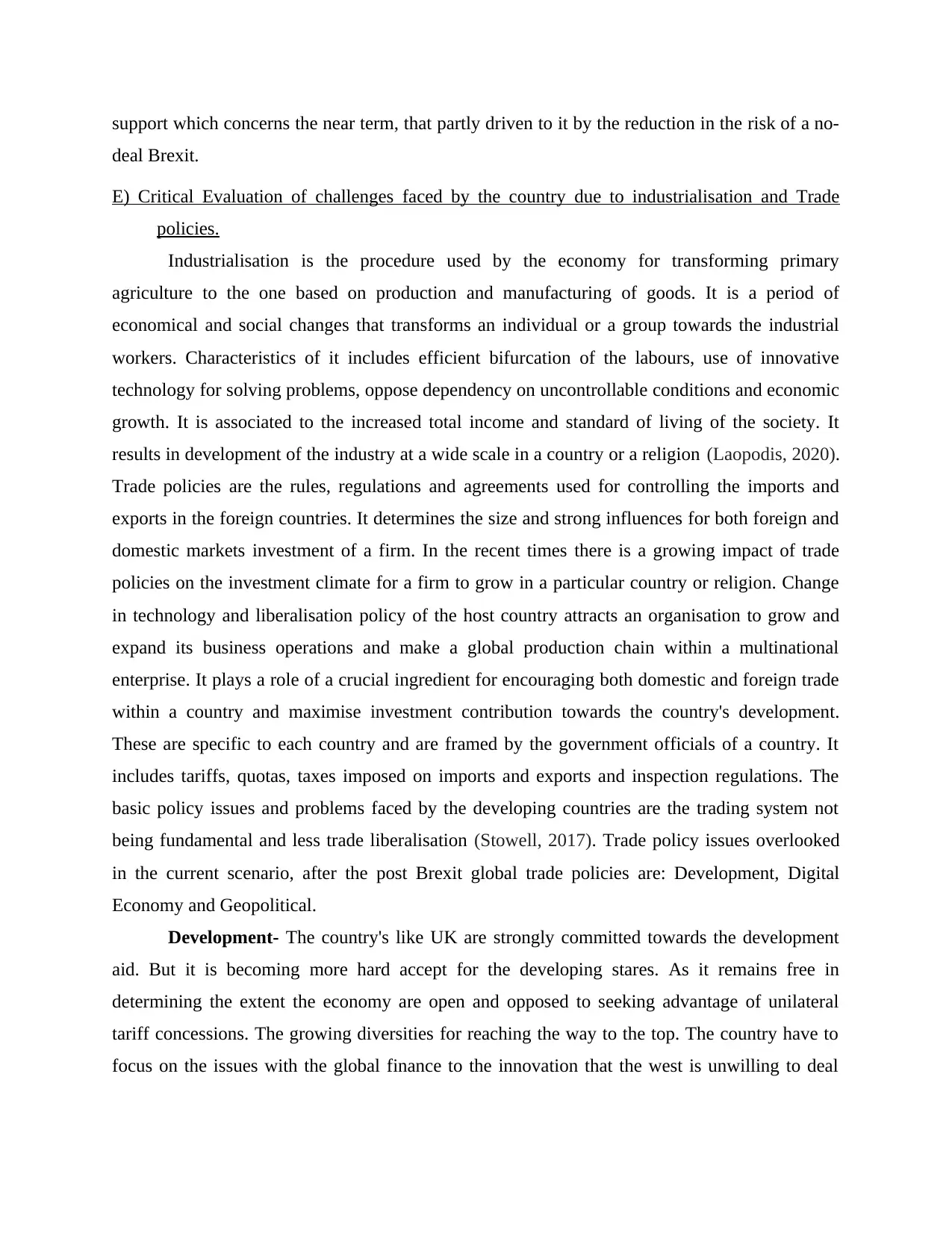
support which concerns the near term, that partly driven to it by the reduction in the risk of a no-
deal Brexit.
E) Critical Evaluation of challenges faced by the country due to industrialisation and Trade
policies.
Industrialisation is the procedure used by the economy for transforming primary
agriculture to the one based on production and manufacturing of goods. It is a period of
economical and social changes that transforms an individual or a group towards the industrial
workers. Characteristics of it includes efficient bifurcation of the labours, use of innovative
technology for solving problems, oppose dependency on uncontrollable conditions and economic
growth. It is associated to the increased total income and standard of living of the society. It
results in development of the industry at a wide scale in a country or a religion (Laopodis, 2020).
Trade policies are the rules, regulations and agreements used for controlling the imports and
exports in the foreign countries. It determines the size and strong influences for both foreign and
domestic markets investment of a firm. In the recent times there is a growing impact of trade
policies on the investment climate for a firm to grow in a particular country or religion. Change
in technology and liberalisation policy of the host country attracts an organisation to grow and
expand its business operations and make a global production chain within a multinational
enterprise. It plays a role of a crucial ingredient for encouraging both domestic and foreign trade
within a country and maximise investment contribution towards the country's development.
These are specific to each country and are framed by the government officials of a country. It
includes tariffs, quotas, taxes imposed on imports and exports and inspection regulations. The
basic policy issues and problems faced by the developing countries are the trading system not
being fundamental and less trade liberalisation (Stowell, 2017). Trade policy issues overlooked
in the current scenario, after the post Brexit global trade policies are: Development, Digital
Economy and Geopolitical.
Development- The country's like UK are strongly committed towards the development
aid. But it is becoming more hard accept for the developing stares. As it remains free in
determining the extent the economy are open and opposed to seeking advantage of unilateral
tariff concessions. The growing diversities for reaching the way to the top. The country have to
focus on the issues with the global finance to the innovation that the west is unwilling to deal
deal Brexit.
E) Critical Evaluation of challenges faced by the country due to industrialisation and Trade
policies.
Industrialisation is the procedure used by the economy for transforming primary
agriculture to the one based on production and manufacturing of goods. It is a period of
economical and social changes that transforms an individual or a group towards the industrial
workers. Characteristics of it includes efficient bifurcation of the labours, use of innovative
technology for solving problems, oppose dependency on uncontrollable conditions and economic
growth. It is associated to the increased total income and standard of living of the society. It
results in development of the industry at a wide scale in a country or a religion (Laopodis, 2020).
Trade policies are the rules, regulations and agreements used for controlling the imports and
exports in the foreign countries. It determines the size and strong influences for both foreign and
domestic markets investment of a firm. In the recent times there is a growing impact of trade
policies on the investment climate for a firm to grow in a particular country or religion. Change
in technology and liberalisation policy of the host country attracts an organisation to grow and
expand its business operations and make a global production chain within a multinational
enterprise. It plays a role of a crucial ingredient for encouraging both domestic and foreign trade
within a country and maximise investment contribution towards the country's development.
These are specific to each country and are framed by the government officials of a country. It
includes tariffs, quotas, taxes imposed on imports and exports and inspection regulations. The
basic policy issues and problems faced by the developing countries are the trading system not
being fundamental and less trade liberalisation (Stowell, 2017). Trade policy issues overlooked
in the current scenario, after the post Brexit global trade policies are: Development, Digital
Economy and Geopolitical.
Development- The country's like UK are strongly committed towards the development
aid. But it is becoming more hard accept for the developing stares. As it remains free in
determining the extent the economy are open and opposed to seeking advantage of unilateral
tariff concessions. The growing diversities for reaching the way to the top. The country have to
focus on the issues with the global finance to the innovation that the west is unwilling to deal
⊘ This is a preview!⊘
Do you want full access?
Subscribe today to unlock all pages.

Trusted by 1+ million students worldwide
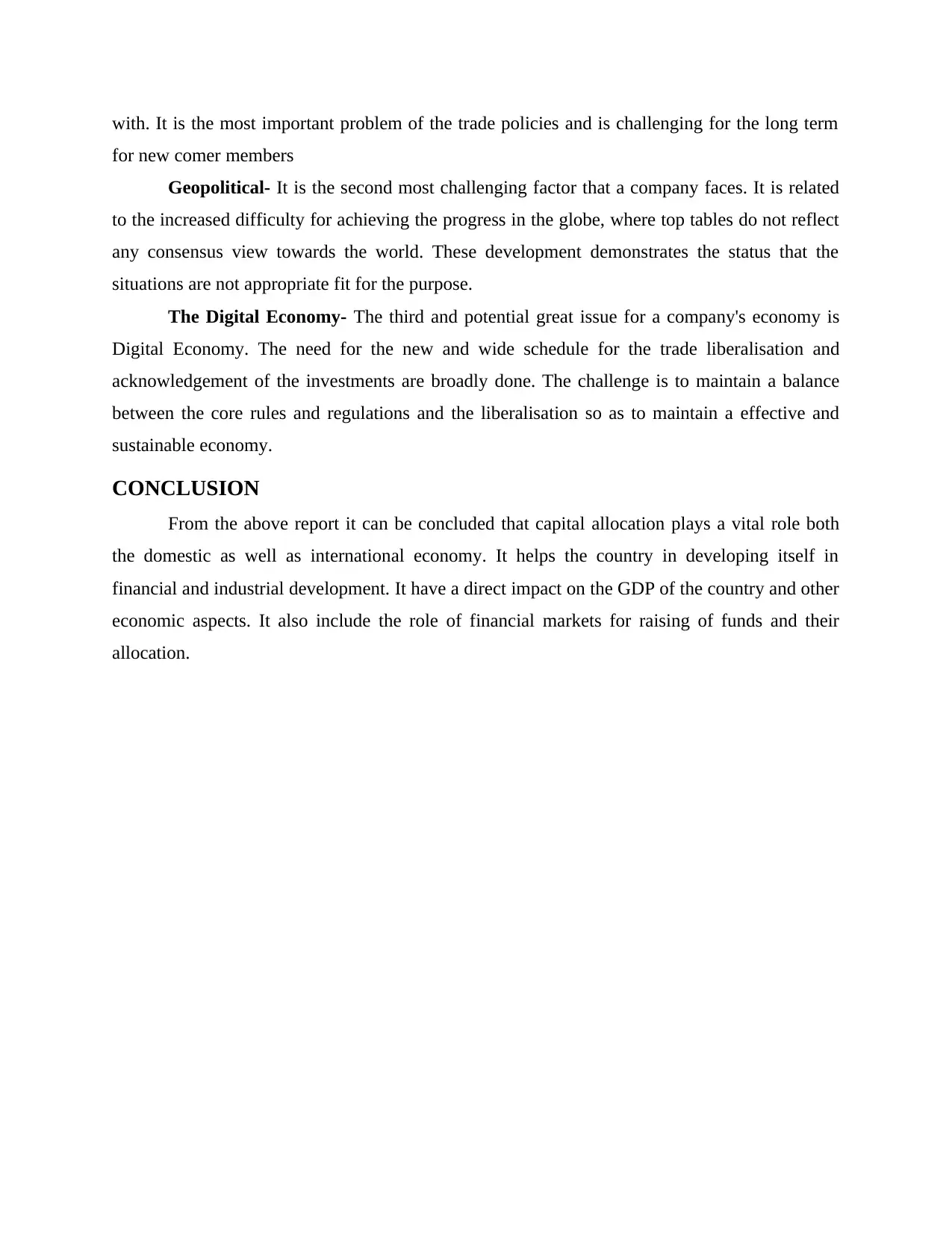
with. It is the most important problem of the trade policies and is challenging for the long term
for new comer members
Geopolitical- It is the second most challenging factor that a company faces. It is related
to the increased difficulty for achieving the progress in the globe, where top tables do not reflect
any consensus view towards the world. These development demonstrates the status that the
situations are not appropriate fit for the purpose.
The Digital Economy- The third and potential great issue for a company's economy is
Digital Economy. The need for the new and wide schedule for the trade liberalisation and
acknowledgement of the investments are broadly done. The challenge is to maintain a balance
between the core rules and regulations and the liberalisation so as to maintain a effective and
sustainable economy.
CONCLUSION
From the above report it can be concluded that capital allocation plays a vital role both
the domestic as well as international economy. It helps the country in developing itself in
financial and industrial development. It have a direct impact on the GDP of the country and other
economic aspects. It also include the role of financial markets for raising of funds and their
allocation.
for new comer members
Geopolitical- It is the second most challenging factor that a company faces. It is related
to the increased difficulty for achieving the progress in the globe, where top tables do not reflect
any consensus view towards the world. These development demonstrates the status that the
situations are not appropriate fit for the purpose.
The Digital Economy- The third and potential great issue for a company's economy is
Digital Economy. The need for the new and wide schedule for the trade liberalisation and
acknowledgement of the investments are broadly done. The challenge is to maintain a balance
between the core rules and regulations and the liberalisation so as to maintain a effective and
sustainable economy.
CONCLUSION
From the above report it can be concluded that capital allocation plays a vital role both
the domestic as well as international economy. It helps the country in developing itself in
financial and industrial development. It have a direct impact on the GDP of the country and other
economic aspects. It also include the role of financial markets for raising of funds and their
allocation.
Paraphrase This Document
Need a fresh take? Get an instant paraphrase of this document with our AI Paraphraser
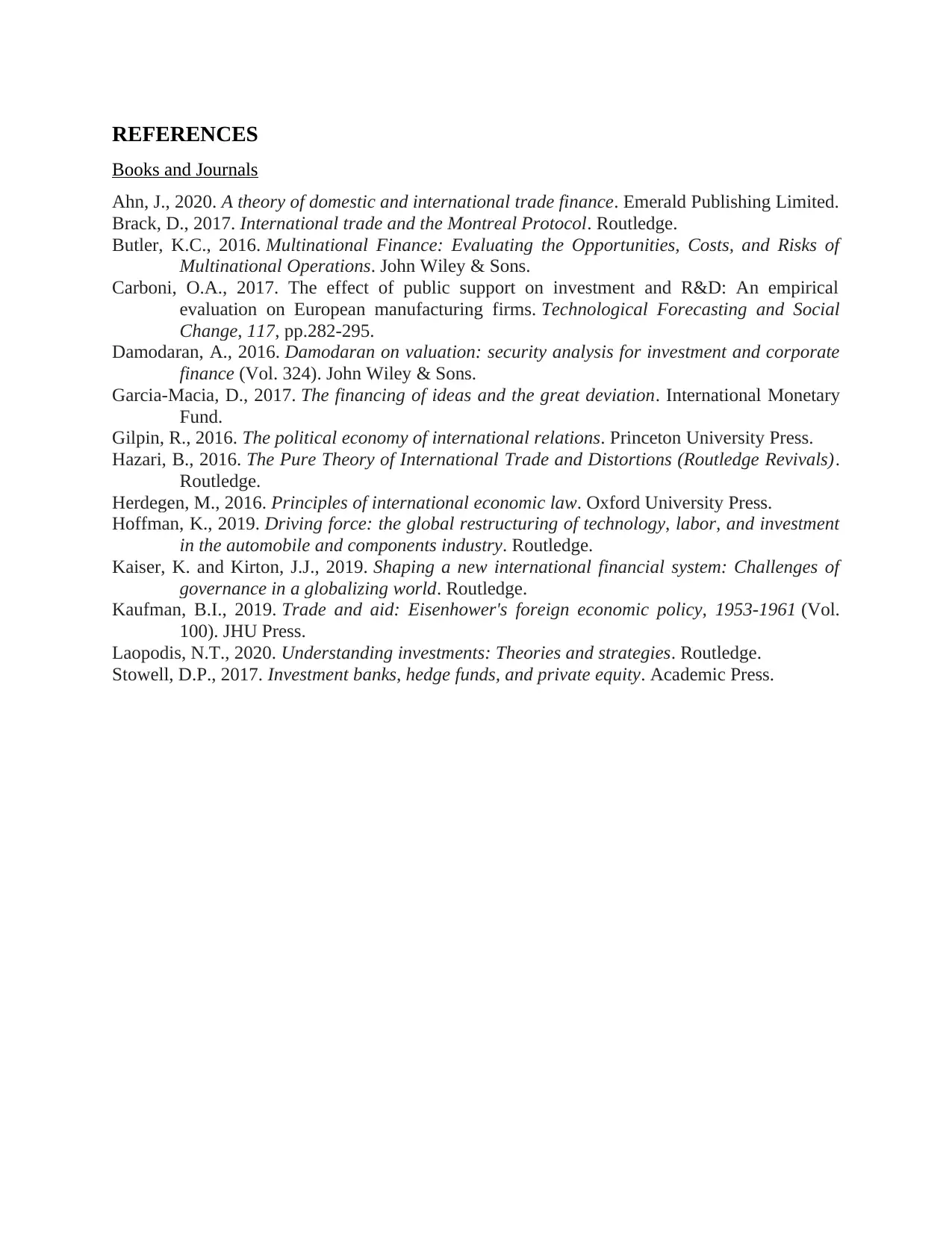
REFERENCES
Books and Journals
Ahn, J., 2020. A theory of domestic and international trade finance. Emerald Publishing Limited.
Brack, D., 2017. International trade and the Montreal Protocol. Routledge.
Butler, K.C., 2016. Multinational Finance: Evaluating the Opportunities, Costs, and Risks of
Multinational Operations. John Wiley & Sons.
Carboni, O.A., 2017. The effect of public support on investment and R&D: An empirical
evaluation on European manufacturing firms. Technological Forecasting and Social
Change, 117, pp.282-295.
Damodaran, A., 2016. Damodaran on valuation: security analysis for investment and corporate
finance (Vol. 324). John Wiley & Sons.
Garcia-Macia, D., 2017. The financing of ideas and the great deviation. International Monetary
Fund.
Gilpin, R., 2016. The political economy of international relations. Princeton University Press.
Hazari, B., 2016. The Pure Theory of International Trade and Distortions (Routledge Revivals).
Routledge.
Herdegen, M., 2016. Principles of international economic law. Oxford University Press.
Hoffman, K., 2019. Driving force: the global restructuring of technology, labor, and investment
in the automobile and components industry. Routledge.
Kaiser, K. and Kirton, J.J., 2019. Shaping a new international financial system: Challenges of
governance in a globalizing world. Routledge.
Kaufman, B.I., 2019. Trade and aid: Eisenhower's foreign economic policy, 1953-1961 (Vol.
100). JHU Press.
Laopodis, N.T., 2020. Understanding investments: Theories and strategies. Routledge.
Stowell, D.P., 2017. Investment banks, hedge funds, and private equity. Academic Press.
Books and Journals
Ahn, J., 2020. A theory of domestic and international trade finance. Emerald Publishing Limited.
Brack, D., 2017. International trade and the Montreal Protocol. Routledge.
Butler, K.C., 2016. Multinational Finance: Evaluating the Opportunities, Costs, and Risks of
Multinational Operations. John Wiley & Sons.
Carboni, O.A., 2017. The effect of public support on investment and R&D: An empirical
evaluation on European manufacturing firms. Technological Forecasting and Social
Change, 117, pp.282-295.
Damodaran, A., 2016. Damodaran on valuation: security analysis for investment and corporate
finance (Vol. 324). John Wiley & Sons.
Garcia-Macia, D., 2017. The financing of ideas and the great deviation. International Monetary
Fund.
Gilpin, R., 2016. The political economy of international relations. Princeton University Press.
Hazari, B., 2016. The Pure Theory of International Trade and Distortions (Routledge Revivals).
Routledge.
Herdegen, M., 2016. Principles of international economic law. Oxford University Press.
Hoffman, K., 2019. Driving force: the global restructuring of technology, labor, and investment
in the automobile and components industry. Routledge.
Kaiser, K. and Kirton, J.J., 2019. Shaping a new international financial system: Challenges of
governance in a globalizing world. Routledge.
Kaufman, B.I., 2019. Trade and aid: Eisenhower's foreign economic policy, 1953-1961 (Vol.
100). JHU Press.
Laopodis, N.T., 2020. Understanding investments: Theories and strategies. Routledge.
Stowell, D.P., 2017. Investment banks, hedge funds, and private equity. Academic Press.

⊘ This is a preview!⊘
Do you want full access?
Subscribe today to unlock all pages.

Trusted by 1+ million students worldwide
1 out of 12
Related Documents
Your All-in-One AI-Powered Toolkit for Academic Success.
+13062052269
info@desklib.com
Available 24*7 on WhatsApp / Email
![[object Object]](/_next/static/media/star-bottom.7253800d.svg)
Unlock your academic potential
Copyright © 2020–2025 A2Z Services. All Rights Reserved. Developed and managed by ZUCOL.





